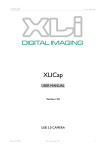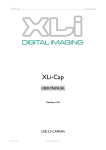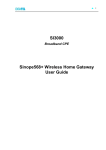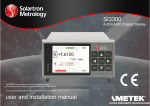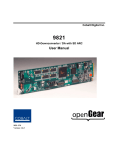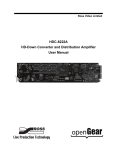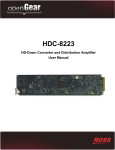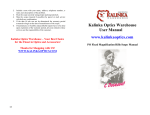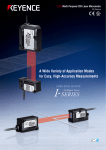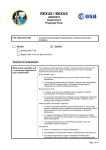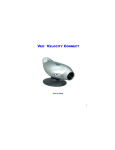Download CETI Si3000 camera etc
Transcript
User Manual Si-3000 Camera USER MANUAL Version 17 June 2008 1 User Manual Contents Welcome ...........................................................2 Warnings and Precautions System Requirements Package Contents ..........................................3 ..............................................4 ..................................................5 Installing Software and Drivers Using XLiCap Trouble Shooting ......................................6 ........................................................13 ..................................................30 Technical Data .....................................................33 Supported APIs ....................................................34 Using TWAIN ..............................................................35 Uninstalling Software and Drivers ..................................37 Welcome Thank you for purchasing our high resolution USB2.0 camera. We suggest you spend a few minutes carefully reading this user manual before installing and using your camera. Please keep this user manual in a safe place for future reference. June 2008 2 User Manual Warnings and Precautions Precautions when using your camera: Keep camera away from the following: · High temperatures and excessive humidity · Direct sunlight or other heat sources · Dust · Extreme vibration Never attempt to clean your camera sensor (filter) with any fluids or use an air blower near the camera as this could damage or degrade the camera and invalidate your warranty. Never touch the sensor with your fingers. Do not allow the camera to come into contact with water or any other liquid. If water or a foreign substance should get in the camera, unplug the camera immediately and do not attempt to plug it in until after a long period of time to allow for drying. This does not necessarily mean it will work again! Do not open the camera case or attempt your own repairs. Internal components may create risk of electrical shock or fire. There are no user serviceable components inside. Additionally, the camera was assembled and cleaned in a strictly dust-free environment. Any attempt to open the case will certainly contaminate the sensor, degrade the image and will void the warranty. Clean the outside of the camera by wiping with a clean, dry cloth. Never use harsh or abrasive cleaners or organic solvents on the camera or any of its parts. If you notice smoke or a strange smell coming from the camera, immediately unplug the camera and consult an authorised dealer. June 2008 3 User Manual System Requirements • 32-bit PC with either Windows ® 2000 SP4 or Windows ® XP SP1 or later or Windows ® Vista • DirectX 9.0 or later installed • 3.0GHz minimum processor • USB 2.0 Port • CD- ROM drive • 256 MB RAM Performance is dependent on your PC's graphics card, processor and USB chip set. USB 2.0 is only supported on Windows ® Vista, XP and 2000. Do not try to use any other Microsoft ® operating system. Please note that 64-bit platforms are not supported. Windows 2000 must have Service Pack 4 (or later) installed and XP Pro must have Service Pack 1 (or later) installed in order for the camera to function correctly. To check if you have USB2.0 installed on your computer go to: Start > Settings > Control Panel > System… or 'right-click' on “My Computer” and select “properties” from the context menu... Click on the “Hardware” tab and then onto the button “Device Manager”; Within Universal Serial Bus controllers (USB controllers) you will see a list of USB devices installed on your machine. In this example the red arrow is indicating the USB2.0 device. USB2.0 controllers may be labelled as USB2.0 controllers, however they may also be labelled as “Enhanced” or “Standard Enhanced” controllers. The so-called “Standard” or “Standard Universal” controllers are for the slower USB1.x system. June 2008 4 User Manual Package Contents 1 x Camera 1 x High Speed USB 2.0 Cable 1 x CD- ROM If any parts are missing from your package, please contact your dealer. On the base of the camera is a label containing the serial number. June 2008 5 User Manual Installing Software and Drivers The installation of this program requires administrator rights. Insert the XLi CDROM into your drive. Do not connect your camera at this point. The installation program should auto-run and display the following Set-up window. If the program does not auto-run then you need to run the setup.exe from the CDROM. To do this, go to “My Computer” and right-click on the CD Drive and choose “Open” or “Explore”: this will show you the contents of the CD- ROM where you can double click the “setup.exe” icon in order to run it. Read the Welcome screen carefully all the way to the bottom and when ready press the “Continue” button. If you do not have the correct Operating System specified you will get the following error message: and will not be able to install XLi software. June 2008 6 User Manual An installation progress report will appear in the window. Connect your camera to the USB 2.0 port on your PC. Windows will detect the new hardware and display the “Found New Hardware Wizard”. The behaviour of this wizard depends on the operating system: Windows XP (and Windows 2000): The first window that appears in XP SP2 asks whether you want to use Windows Update on the Internet to find drivers for this new hardware (providing you have not previously checked the “Yes, now and every time I connect a device”) The option “No, not this time” should be chosen, otherwise “Windows Update” will spend a while searching for a non-existent driver for the camera on Internet and will complain that it cannot find one. June 2008 7 User Manual Press the “Next” button. Select the “Install from a list or specific location (Advanced)” button and click “Next”. Select the radio button “Search for the best driver in these locations”. Tick the “Search Removable Media” checkbox, untick the “Include this location in the search” checkbox and click the “Next” button. You will see the following warning: June 2008 8 User Manual The actual driver name given in this screen (and on some of the screens thereafter) will have the “XXX” replaced with the model of camera you are installing. Press “Continue Anyway” when this window shows. When Windows has finished installing the camera driver, click finish. June 2008 9 User Manual Windows Vista: Warning - the New Hardware wizard on Windows Vista does not always appear “on top” of other windows that may be displayed on the screen. Sometimes you have to spot the flashing button on the task-bar at the bottom of the screen and click it to get the wizard on top and usable. Once it is visible, the wizard’s first screen looks like this Choose “Locate and Install Driver Software (recommended)”. If your machine is connected to internet, Vista will now unavoidably go and search one of Microsoft’s driver-repositories for a suitable driver. After about 30 seconds it should give up and present you with a screen as follows: June 2008 10 User Manual You just hit “Next” at this point, and the wizard will look at the supplied CD ROM. It will find the driver, but Vista’s security system will want confirmation that it can load it: Select “Install this Driver Software anyway” and click on it. The wizard will now complete the process of loading the driver and present a box looking like this: If you have several of our cameras, the wizard will loop around and install the others in a similar way. June 2008 11 User Manual Windows Vista, XP or 2000: It is unlikely, but you might get an error report on this final screen if the driver found that it couldn’t run: Error code 10 is where the camera driver started up but failed to find the camera hardware. Please contact the Dealer where you purchased the camera if this happens. Error code 37 is where the driver detected a Pentium II (or earlier) processor type. We’re sorry, but the camera is a high-performance, high-bandwidth device and processors older than the Pentium III just won’t work with it. Assuming you see the screen above, installation is now complete for this particular camera/port. If you have another camera or intend to use an an additional port, plug the camera cable into your chosen port in order to install additional drivers via the “Found New Hardware Wizard”. Once the installation is complete, you should see a shortcut on your desktop called XLiCap . In the Start -> Programs listing you will also see a folder for XLiCap. The software is automatically installed for all users of the PC. XLiCap will remember each users preferences. June 2008 12 User Manual Using XLiCap To open the XLiCap program double click the icon on your desktop. The main window will be opened and the real-time image from your camera will be displayed in the viewing window. Initially the program shows a toolbar that allows quick access to most functions. Additionally, right clicking on the viewing window will pop up a context menu that can be used to control addition functions and enabling /disabling the toolbar and main menu. Toolbar Above the image display you will see the Main Toolbar: The Toolbar is split into 7 different groups: File Group Save : When the “Save” button is pressed, whatever image is currently being displayed will be captured as a still image. The default location is the Desktop, the default format is JPEG and the default file name is “image”. For every subsequent press of the “save” button, a new image will be captured with an incremental number suffixed. [e.g. “image0.jpg” followed by “image1.jpg” then image2.jpg” and so on.] June 2008 13 User Manual Save As : When the “Save As” button is pressed, the currently-displayed image is captured and the standard “save as” dialog box opens. Here you can specify a file name, location and file type of the image to be saved. Available file types are “JPEG”, “BMP” and “TIFF”. Once this has been done once, this file name, location and file type now become the default for the “save” button. Every press of the “save” button now saves the image to the new location, with the new name and format with an incremental suffix number. [e.g. Save as “mypicture.bmp”, then next time “save” is pressed a new image will be captured called “mypicture0.bmp” and then “mypicture1.bmp”, “mypicture2.bmp” and so on until a new file name, location and/or file type is specified.] Copy: When the “Copy” button is pressed, the current displayed image will be captured and copied to the clipboard. This allows you to paste the image into another program. Email: When the “Email” button is pressed, whatever the current display is showing will be captured and saved as if the “save” button had been pressed. It will also be attached to a “new email” using the default email client of the PC. You will be able to edit this email before sending it. Graphics Overlay Group Annotation: When “Annotation” is pressed, the selected annotation will be displayed as a graphics overlay on the viewing window. Pressing the button again removes the annotation. The “Annotation” button has a right-click context menu to display the “Annotation” or “Text label” dialog box. Alternatively, select “Annotation” from either the edit menu, the main context menu, or by pressing “Ctrl + A”. Any of these will display the “Annotation” dialog box: In the “Caption” field, change the default word “Caption” to the required text. To make your caption the base filename for image saving, select the “Use as Filename” checkbox. (see “Save” and “Save As...”) The current time and date will be displayed when the “Show Time Date Stamp” check box is selected. The size, and colour of annotation text may be chosen using selection boxes provided. June 2008 14 User Manual Reticule: When “Reticule” is pressed, the selected reticule will be displayed as a graphics overlay on the viewing window. Pressing the button again removes the reticule. Several reticules are included with the program, with the “Scale” reticule being the default one. The “Reticule” button has a right-click context menu to select alternative reticules. Note, each reticule is a file with extension “gti”that is stored in a sub directory to the main XliCap program, called “reticules” (c:\ program files\XLiCap\reticules). In addition to the supplied reticules, it is possible for the user to create their own custom reticules by creating a new “gti” file and saving it in the reticules directory. XLiCap will automatically add the new reticule to the existing list. Further information on how to create your own reticule can be found by reading the “readme.txt”in the reticule directory. The reticule colour can be selected from the additional “Colour” drop down menu. Mouse Mode Group Select: When this button is depressed, XLiCap is in "Select Mode". In this mode, a click on a drawn line, a text label or a measurement will select it for the duration of the button bring pressed. (See “Draw” and “Measure” modes below). The selected item will be highlighted in a dotted rectangle. The selected item can be moved about the screen by dragging the mouse. Use the delete key to remove any selected item (you have to hit the delete key whilst still keeping the mouse left-button depressed). Change the angle of any selected text label. Use the following keys whilst still keeping the mouse left-button depressed. Numeric keypad “+” key or PGDn to rotate clockwise. Numeric keypad '-' key or PGUp to rotate anticlockwise. June 2008 15 User Manual The “select” button on the toolbar has its own right click context menu to “Erase All” lines and measurements and text labels. This will not erase the annotation caption, Date Time stamp or reticule. For convenience, “Select” mode combines the feature of “Pan” mode(see below) but only if the mouse is clicked in open space, away from drawn lines, text labels or measurements. In this case, the mouse cursor switches to the following icon: ...and if the camera’s image doesn’t fit the screen, then the mouse can drag it around to that different areas can be displayed. Draw: When this button is depressed, XLiCap is in "Draw Mode". You can draw lines in this mode by simply holding down the left mouse button and dragging. This button has its own right click context menu from which you can choose a pen colour and pen size for drawing (see below): Note: Any pen setting changes will apply to subsequent drawing and measurements. Line Measurement: When this button is depressed, XLiCap is in "Line Measure Mode". Hold down the left mouse button over a section of the image and drag to somewhere else in order to take a measurement. The cursor changes to a pointing finger. The Measure button has its own right-click context menu. Selecting “Edit”from this menu brings up the “Scales” dialog box. From here we can add a new scale, edit an existing scale, or delete an exiting scale. Using Measure Mode - Let's say we are using a microscope in a 10x magnification mode and prefer our measurements displayed in micrometres and millimetres, and not pixels. We focus on a 1000 micrometre reticule slide, click the measure button to switch to "Measure mode" and measure the scale on the slide. The line drawn will have a length in pixels as its value. June 2008 16 User Manual Now right-click on the Measure button and select “Edit” from the context menu to bring up the “Scale” dialog box. Click the "Add" button to create the new scale: The number of pixels that equates to your 1000 micrometre slide is automatically entered to the “Pixels” box (800 in this example). You can change it should you wish to. Enter the matching physical length of your scale in the “Size” box. Notice that you can select whether to work in µm or thou by means of the radio-buttons provided. Enter a meaningful name for the scale in to the “Name” box (“10x” was used for this example). Once done, click "OK" and "Close". If you select the “Scale Bar” check-box then whenever this scale is being used (see below) then a scalebar representing (in this case 1000µm) will be displayed as an annotation on the screen. To try out our new scale, right-click on the measure button and choose the "10x" scale (which we just created) from the context menu. Any future measurements will be displayed in micrometres and millimetres. These values will be accurate for the 10x mag setting of the microscope. We can add additional scales to the context menu to support more magnification modes, by repeating the procedure above. Note: A change of magnification without selecting a new scale makes any measurements meaningless. Area Measurement: When this button is depressed, XLiCap is in “Polygon Area Measure Mode”. Click the left mouse button on a corner of an area to be measured, then proceed around the shape, clicking on every point where the perimeter changes direction. Finish the polygon with another click on the Area Measure button or press the ‘Esc’ key on the keyboard. The last point on the polygon that you defined will be joined to the first, the polygon will be filled in on the screen and its area will be displayed. As with linear measurements above, the system has to be calibrated for this value to have any meaning. Please do not try drawing shapes that involve the perimeter crossing itself (as with a figure-8 or bow tie shape). The results will not be meaningful. June 2008 17 User Manual Pan: This is the default mouse mode. Holding the left-button on the mouse down over the viewing window changes the cursor to the following icon: This allows the image in the viewing window to be panned around, should not all of the camera image be visible (such as in 1:1 zoom). Hold down the left button and drag the image in the desired direction. Notice that this facility is also available in “Select” mode (see above) but in that mode it depends on the mouse being clicked away from any lines, labels or measurements. Camera Functions Group Resolution: This button toggles between the high-resolution and low-resolution modes of the device. High-resolution is indicated by a fine grid of squares and low-resolution mode is represented by a coarse grid. To check what resolution you are running in you can hover the mouse over the “resolution” button and a tool tip will appear, indicating the mode in which the device is running. Zoom: When in “High-resolution” there are two zoom settings available: “Fit to Window” and “1:1”. Once the button is depressed, each new click will toggle through these settings. Note: in “Low-Resolution” mode the zoom is always “Fit to Window”. Fit to Window – Scales the image to fit whatever size window is being used, while maintaining the camera sensor aspect ratio. 1:1 – Displays pixels one-to-one on the screen. Flat Field Compensation: When this button is red, flat field is off; when green, flat field compensation is on. Note: Flat field is performed on a pixel by pixel basis in software. More information can be found in the “Camera Controls” section. June 2008 18 User Manual Freeze: Pressing this button will instantly freeze-frame the image, and the green “traffic lights” icon will change to a red light icon to indicate that the image is frozen. When the image is frozen, the still image can be saved, emailed, copied and drawn on using the appropriate buttons - just as above. Press the “Freeze” button again to resume live video. The “traffic lights” icon will be green when the video is live. Colour: When this button is pressed the image will change to monochrome mode (black and white) and the button's icon appears as grey stripes. Press the button again to return to full colour mode, and the button will appear as coloured stripes. Note: This button is disabled if you have a monochrome camera. Invert Colours: This button may be used to toggle between negative and positive images. Camera Controls: This button opens the “Camera Controls” dialog box as described later. Luminance: This slider controls the luminance target for automatic exposure and gain. See the Camera Controls for more details. AUTO/MAN: This button is used to toggle between AGC+AEC and manual exposure and gain. Sensitivity: This up/down control is used to select how sensitive the camera should be. The higher the value, the more more sensitive the camera will be. Increasing sensitivity means that less exposure is needed to achieve a given luminance target. Sometimes you may want to increase the minimum exposure, so in such cases it may be necessary to reduce sensitivity. This is often the case when using a mains banding filter. June 2008 19 User Manual Video Recording Group: Record: When this button is pressed, the current live image will begin to be recorded. Whilst recording, all other functions are inactive. The recording will be made in whatever resolution setting is currently selected. Counter: Once “Record” has been pressed and live video is being recorded, the time elapsed will be displayed here. Maximum time allowed per recording is 20 seconds. Stop: To stop the video being recorded press this button. Once stopped, the “Save Movie As” dialog box appears. Here you can give the video a name and choose where to save it. Default location is the Desktop. AVI is the only format available. June 2008 20 User Manual Help: This button opens the “About” and “Quick Help” screen, showing release information (which may vary from that shown below) and shortcut keys for various features: June 2008 21 User Manual Main Menu By default the Main Menu is not shown. Most of the main menu functions are directly accessible by the standard toolbar. If desired it can be enabled by right clicking on the viewing window and checking “Show Menu” from the context menu. The main menu has the following options: File: Save – same as the “Save” button on the Toolbar. Save As – same as the “Save As” button on the Toolbar. Email – same as the “Email” button on the Toolbar. Exit - Click on “Exit”to close the program. Note: Always “Exit”the program before unplugging the camera; system crash may result otherwise. Edit: Copy – same as the “copy” button on the Toolbar. Erase All – This deletes all drawing and measurements from the display. Edit Annotation.. - This opens a dialog box allowing the annotation to be edited. Annotation is discussed above in the “Toolbar” section. Mode: Select Item – This switches to selection mode. The current state is indicated by the dot mark. Draw – This switches to draw mode. The dot mark in the sub menu indicates the current state. Measure – This switches to measure mode. The current state is indicated by the dot mark in the sub menu Measure Area – This switches to measure-area mode, described under the Toolbar options earlier. Pan – This is the default mouse mode in the viewing window for panning the camera image. June 2008 22 User Manual View: Resolutions – Selecting this opens a sub-menu showing the available resolutions for the current camera. The current resolution is indicated by the check. Freeze – same as the “Freeze” button on the Toolbar. When the image has been frozen, this option will be checked. Camera Controls – This will open the “Camera Controls” dialog box where you can control settings of the camera. This is discussed in more detail later. Options: Show Menu – Display or hide the main menu bar. Show Toolbar – Display or hide the Toolbar. Button Saves Image – This option is only available on cameras with buttons. If it is ticked, then when the button is pressed and the image is live, then the image will be saved to disk using the same rules as if the “Save” button on the toolbar had been pressed. Button Freezes Image – This option is only available on cameras with buttons. If it is ticked, then when the button is pressed, the image will be toggled from frozen to live. If “Button saves Image” is also ticked, the image will only be saved on each transition from frozen to live. Factory Reset – By selecting this, all settings will be returned to their factory defaults as seen when the camera was supplied. This includes camera settings and program settings. Devices : This menu lists all supported camera devices that are currently available to be viewed using the software. The device currently in use will be indicated. To switch between devices, simply click the one you wish to view. Help: This will open up the “About /Quick Help” dialog box, as does the “Help” button on the Toolbar. June 2008 23 User Manual Context Menu At any time, you can right-click on the viewing window to call up the context menu. All the menu items here do the same as the corresponding items on the Toolbar, button context menus and Main Menu. The “Button Saves Image” and “Button Freezes Image” options will be greyed-out if the camera doesn’t have a button.. Show Menu – When checked, this enables the main menu, which by default is not displayed. Show Toolbar – When checked, this enables the toolbar, which by default is displayed. Text Label – A click here will display the “Text Label” dialog box. This allows us to select the text, size and colour of a new text label. To change the default colour and size for text labels, simply select new values from the dialog box selectors. Future text labels, including those used for measurements, will have these attributes. Just like any other lines and measurements, a label (once created) can be selected and moved about the screen (or be deleted). The initial position for a newly-created label is the point on the picture where the right-click happened to bring up the context-menu in the first place. Full Screen Display To toggle full screen mode you can press Alt+Enter keys at the same time. June 2008 24 User Manual “Camera Controls” dialog box The camera controls dialog box contains 2 tabbed panels that give the user full control over camera settings. The dialog box can be left open if desired, and the main XLiCap window can continue to be used as normal. All sliders and setting values are displayed in real time giving live feedback on the camera. Sliders can be adjusted finely using the keyboard. To do this, click on the slider to be adjusted and using the arrow keys on the keyboard or the mouse wheel, small increments can be made. Main Panel R,G and B Sliders – Used to set the colour balance of the camera by manually controlling the proportions of red, green and blue in the image. RST – This button restores colour balance to the factory default without changing any other settings. June 2008 25 User Manual AGC –The camera's gain can be set manually by unchecking the AGC auto box and dragging the slider, or AGC (automatic gain control) can be activated by checking the AGC auto box. If AGC is active then the manual slider is disabled, but is updated in real-time as the camera self-adjusts the image. AEC –The camera's exposure-time can be set manually by unchecking the AEC auto box and dragging the slider, or AEC (automatic exposure control) can be activated by checking the AEC auto box. If AEC is active then the manual slider is disabled, but is updated in real-time as the camera self-adjusts the image. The current exposure-time (in milliseconds) is shown to the right of the slider. LUM –The Luminance target for AEC and AGC. This can be left on automatic, or manually adjusted by the user. ● ● Automatic – When the auto box is checked, the luminance target for the image is automatically set to an optimum level controlled by the driver. Manual – When the auto box is not checked, the luminance target for the image is that specified by the user using the Luminance slider control. The AEC/AGC system will attempt to produce an image with the requested luminance target. Exposure and gain are adjusted until luminance is as near to the the target is possible. With both AGC and AEC checked, the image will have an optimum level of exposure and gain for the desired target. The Luminance bar also contains a light meter that indicates the amount of light the camera is detecting. If the bar is empty, then the camera is not detecting any light. Likewise, if the bar is completely filled blue the camera is detecting too much light (saturating). When using a manual luminance target, the luminance bar has a slider that allows a target luminance value to be set as detailed above. In this case you would expect the blue bar to be very close to the sliders thumb. If this is not the case it indicates a problem achieving the desired luminance target. Have we run out of exposure? Or do we need more gain? Or just need to get more light on the subject? Looking at the camera controls should quickly answer these question and lead to a solution. Exposure range can be increased by reducing frame rate. The need for more gain can often be removed by increasing the sensitivity of the camera via the sensitivity control, or just increase the light getting to the camera. June 2008 26 User Manual FPS – This slider is used to control the frame rate of the camera sensor. On computer systems that struggle to operate with very high USB bandwidth products such as XL Imaging mega pixel cameras, this slider can be used to reduce the frame rate to alleviate problems such as: ● Fix "black screen" problems. ● Fix “horizontal rolling” of the camera image in the viewing window. ● Fix poor frame rate problems - the blue bar inside the slider indicates the actual frame rate being achieved. If this is consistently less than the requested value it is indicative of a bad USB chipset or a slow CPU. Try requesting a slower frame-rate from the sensor until the requested rate and the achieved rate agree. Additionally, reducing the frame rate allows higher exposure values for greater sensitivity. AUTO/MAN – This button is used to switch between AGC+AEC and manual exposure and gain. Filter – Here you can select a mains banding filter that matches your local mains frequency (50Hz or 60Hz). This is provided for use with low quality mains light sources that cause interference in the form of horizontal bands appearing on the image. A quality light source won't exhibit this fault, so filter may remain switched off. As a general rule, only select 60Hz if you are in Canada, Korea, Western Japan (i.e. Osaka, Kyoto, Nagoya, Hiroshima), Saudi Arabia, USA (and possessions), Central America or the northern part of South America (i.e. Peru and Brazil and to the north of them). If selected, the banding filter forces exposure timing to be a multiple of half the period of the local AC supply. If operating in manual exposure mode, then the 'exposure' slider will skip along in multiples of 10ms (50Hz mode) or 8.3ms (60Hz mode). Default - Resets all program and camera settings to the factory settings as when originally supplied. This is equivalent of clicking on “Factory Reset” from the context or main menu. June 2008 27 User Manual Image Panel R ,G ,B – These sliders can be used to control the individual colour channels of the camera. Each channel can be set to a value between 0 and 255, which equates to 0 to 100%. These sliders are intended to be used for image adjustment, not colour balance. Saturation – This slider controls image colour saturation, but is inactive if the camera itself is monochrome, or if it is a colour camera in monochrome mode. Contrast – The Contrast slider controls image contrast. Gamma – The Gamma slider can be used to apply a non-linear correction factor from 0.45 to 1.00. A gamma value of 1.00 (default) is the same as no correction at all. A value of around 0.62 is often suggested as providing the most natural “real life” images for viewing on computer monitors. Mono – checking this box changes to black and white mode (this function is also provided on the Toolbar). This option is permanently disabled and checked if the camera is monochrome. June 2008 28 User Manual Flip – This flips the image from top to bottom. Mirror – This mirrors the image from side to side Invert – The “Invert” button flips the current curve right to left. It effectively makes the camera generate photographic negatives. It can allow a user to examine real photographic negatives naturally of course ( this function is also provided on the Toolbar). FF (Flat Field) Compensation – This is initiated by checking the “Flat Field” box (or by selecting the “FlatField” Toolbar button). It should be performed with the camera looking at a uniform white object. June 2008 29 User Manual Trouble Shooting WARNING: Please do not attempt to open the camera case. There are no user serviceable parts inside. “No Compatible Camera was detected” error dialog box appears when trying to open software: If an error message appears similar to this whilst trying to open the program press “OK”. The software did not detect any compatible devices and therefore will not open. Check the device is plugged in correctly. This error could mean that the camera is not connected properly, drivers are not installed correctly and/or that the USB2.0 port on the computer is not functioning correctly. Check that the camera’s cable is securely connected to the USB port of the computer and camera where applicable. Also ensure that the port on the computer is USB2.0. Some computers may have separate ports for USB2.0 and USB1.1. Consult your computer's user manual. Exclamation Marks or Question Marks in Device Manager Look in Device manager for any devices that have an exclamation mark or question mark. These symbols indicate that a device hasn't installed correctly. This is likely to be contributing to any problems you are having. Check Device Manager for a Section named: “Imaging Devices”. Click on the plus sign to the left of this entry to list any cameras and scanners that are currently plugged into your system. If the camera has installed without error, you should see an entry named: “Si-3000 Camera” for example. If you don't see this entry, or it is listed with an exclamation mark, then drivers haven't installed correctly. If there is an exclamation mark next to the entry, right click on the Camera name and choose the option to update the driver from the CD. After the update, check Device Manager to ensure that the exclamation mark has gone. June 2008 30 User Manual USB Device Conflicts When there are a number of USB devices installed at the same time, unexpected errors can arise. The cause can be insufficient available USB2.0 bandwidth, or possibly too much combined current being drawn by USB devices. To test for these conditions you should uninstall and unplug as many other USB devices as possible. This should help to rule out the above, and eliminate possible conflicts with other cameras. USB2.0 Port Problems The USB2.0 port may not be functioning correctly on your computer. Check “Device Manager” found under “system” in the “Control Panel”. We usually find that the USB2.0 drivers supplied with Windows (or its Service Packs) are the best to use with our camera. If you have installed other USB2.0 drivers and you get a black screen with XLiCap, try uninstalling the USB2.0 drivers and use the default Windows drivers. If the program now works, this indicates a problem with the previous drivers. We have found this to be a problem with a number of motherboard-supplied drivers. Consult a suitable computer technician if in doubt. “I get an error message when trying to install XLiCap Software!” If you receive the error message shown below, then the most likely cause is that you do not have “write-access” to your hard drive. Please consult your computer administrator. June 2008 31 User Manual Image Problems Viewing window is black: Check the camera LED is flashing, if it is not then the camera is not outputting any data. Check the lens iris is open and the camera is pointing towards some light source. The luminance indicator bar in the camera controls dialog box will confirm if the camera is detecting any light. If you still do not get an image, try reducing your frame rate slider (FPS) on the camera controls Main Tab to a level that your computer system can cope with. Image rolling horizontally: This is normally due to insufficient computer system performance (USB performance particularly). Again, try reducing your frame rate slider (FPS) on the camera controls dialog box to a level that your computer system can cope with. Poor frame rate problems: The blue bar inside the FPS slider on camera controls dialog box indicates the actual frame rate being achieved. If this is consistently less than the requested value it is indicative of a bad USB chipset or a slow CPU. Try requesting a slower frame rate from the sensor until the requested rate and the achieved rate agree. Image freezes: If the camera image freezes check the camera LED is still flashing. If it is then the computer system is struggling to maintain the USB rate and has stalled for the camera. Changing the camera resolution, or performing a factory reset will restart the image streaming again. If you experience frequent image freezes then it is recommended to reduce the requested frame rate as above. June 2008 32 User Manual Technical Data SI3000 3 Mega-pixel camera (Colour) • 2048 x 1536 high resolution mode • 1024 x 768 low resolution mode • ½” CMO S Sensor • 12 fps high resolution • 27 fps low resolution Please note that stated frame-rates are maximums. Suboptimal computer hardware may mean that these rates cannot be achieved. June 2008 33 User Manual Supported APIs DirectShow The camera driver operates as a DirectShow source-filter. As such, it can be used by other DirectShow application programs, and is not limited to working with the supplied “XLiCap ” application. The camera supports the standard “Microsoft DirectShow ®” API and the “Microsoft VFW (Video for Windows) ®” API. Documentation for the DirectShow and VFW API, is available from Microsoft and other places. “DirectShow ®” is supported by “Microsoft Visual C++” and “Borland Delphi” programming languages. “Microsoft Visual Basic” supports only a subset of the full DirectShow API. Software Development Kit (SDK) A comprehensive SDK for the camera is included on the installation CD, this allows the creation of your own custom application. Please refer to the CD for the SDK manual and example programs. TWAIN The camera driver additionally provides a TWAIN ® interface. The camera will appear as a selectable image-capture device within TWAIN based image manipulation software. Thus, software designed to work with a TWAIN camera/scanner may use our cameras. Further instructions on using our cameras with TWAIN can be found below. Documentation for the standard TWAIN API is available from: www.twain.org June 2008 34 User Manual Using TWAIN 1. Make sure the camera is installed and connected to your computer. 2. From your chosen 3rd party image application, select the “Acquire Twain” option which will result in the following window being displayed: 3. Highlight the XLi Twain source and click on “Select”. 4. The TWAIN driver will start: 5. The program displays a live viewing window, and allows the camera to be controlled using the “Resolution” and “Camera Controls” button. See previous sections for details of individual camera control settings. 6. Clicking on the “Camera Image” button (or the “Snap” option in the file menu) will cause the Twain window to close and transfer the current camera image back to the 3rd party image application. The Twain driver also allows you to have a twin viewing panel to compare captured images before transferring them back to the 3 rd party image application. To enable this, right click on the viewing window and select “Twin Panel”. June 2008 35 User Manual 7. The left panel continues to display the live camera image. When the “Capture Image” (or File -> Snap) button is now pressed, the captured image is displayed in the right panel and the “Transfer Stored Image” button appears. Transfer Stored Image 8. Any number of captures can be done until you are ready to transfer the desired captured image. Clicking on the “Transfer Stored Image” button will cause Twain to close and transfer the captured camera image back to the 3rd party image application. June 2008 36 User Manual Uninstalling Software and Drivers To uninstall the XLiCap Software and all drivers for our cameras, go to “add/Remove Programs” located in: Start > Settings > Control Panel > And select “XLiCap” from the list by clicking the “Change/Remove” button. For each camera driver removed, you will get a confirmation message: Press “OK” to finish. June 2008 37





































